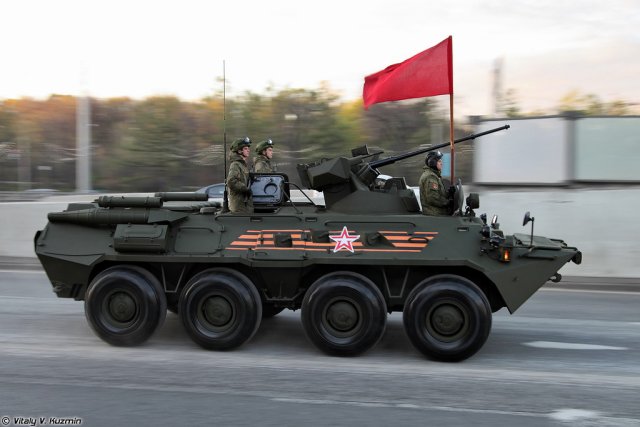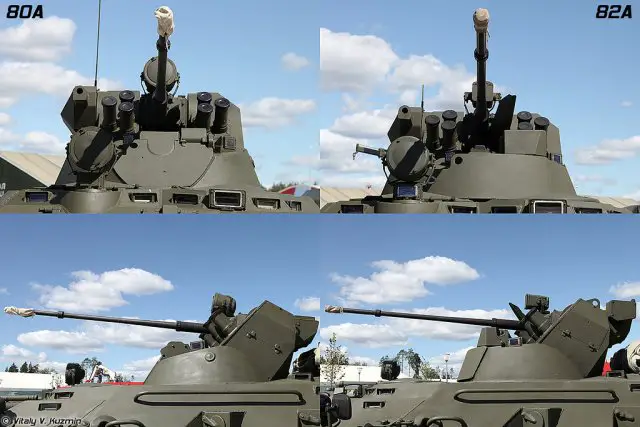BTR-82A Armored Personnal Carrier to receive anti-tank gun 51908163
|
|
|||
|
Defence & Security News - Russia
|
|||
|
|
|||
| BTR-82A Armored Personnal Carrier to receive anti-tank gun | |||
|
Russia`s BTR-82A armoured personnel carrier developed by the Military Industrial Company (Russian acronym: VPK, Voyenno-Promishlennaya Kompaniya) will receive a remote controlled weapon station (RCWS) armed with the 57 mm naval gun, according to a source in the Russian defense industry.
|
|||
|
|
|||
|
|
|||
|
"Russia`s Ministry of Defense (MoD) has taken the firm decision to increase the firepower of the BTR-82A APC and to up-gun it. The upgraded BTR-82A will have its 30 mm Shipunov 2A72 automatic cannon replaced by the naval gun chambered for 57x348SR mm round. The APC will be able to eliminate medium infantry fighting vehicles (IFV) and lightly armoured modern main battle tanks (MBT) on the battlefield. The gun will be integrated with the AU-220M RCWS developed by the Burevestnik scientific-research institute (a subsidiary of the Uralvagonzavod scientific-production corporation). The MoD is discussing the aforementioned project with the indigenous defense industry. The military will have to outline the combat tasks to be set before the up-gunned BTR-82A APC. The relevant studies have already been initiated," the source said.
BTR-82A is the further development of the BTR-80 8x8 wheeled armoured personnel carrier developed in the mid-1980s. The vehicle features a 30mm Shipunov 2A72 automatic gun instead of KPVT heavy machinegun chambered for 14.5x114 mm round of its predecessor. BTR-82A incorporates a state-of-the-art inertial/GLONASS navigation system, an advanced communications and sensors suite, an improved diesel engine, new sighting systems, and reinforced counter-mine protection. Russia`s MoD has ordered over 1,000 BTR-82/82As to equip Motor Rifle, Naval Infantry, Reconnaissance and Special Forces units. |
|||
|
|
|||
|
|
|||
|
"The installation of the 57 mm naval gun will significantly increase the firepower of the vehicle. It has a firing rate of about 120 rounds per minute. The aforementioned gun can eliminate all types of modern medium IFVs on the battlefield. The integration of the AU-220M Baikal RCWS with the upgraded BTR-82A armoured personnel carrier will also increase the internal volume of the vehicle," the source said.
It is noteworthy that the AU-220M unmanned turret is in high demand on both domestic and global arms markets. For instance, Kazakhstan`s MoD has integrated the station with the Barys wheeled armoured vehicle (a licensed copy of the Mbombe IFV developed by the South African Paramount Group). In 2015, the Emirates Defense Technology (EDT) company from the United Arab emirates (UAE) signed with Russia`s JSC Rosoboronexport (a subsidiary of the Rostec state corporation) the agreement to integrate the AU-220M unmanned module with the Enigma 8x8 wheeled APC. "Several nations have already revealed their interest in the acquisition of the AU-220M Baikal RCWS," the source added. |
|||
|
|
|||
 An image showing the AU-220M RCWS fitted on a BMP-3 IFV (Photo: Burevestnik) An image showing the AU-220M RCWS fitted on a BMP-3 IFV (Photo: Burevestnik) |
|||
|
|
|||
|
According to the official specifications provided by the VPK company, the BTR-82A APC has a combat weight of 16,000 kg, a maximum road speed of 80 km/h, a maximum swimming speed of 9 km/h, and an operational range of 700 km. The vehicle is armed with a 30 mm Shipunov 2A72 stabilized cannon and a 7.62 mm Kalashnikov PKTM coaxial machinegun. The carrier is powered by the KAMAZ 740.14-300 turbodiesel engine (300 h.p.). BTR-82A is armoured at Level 2 STANAG 4569 (all-round protection against 7.62 mm steel core armour-piercing bullet at a 30 m distance). The vehicle is supposed to replace the BTR-80/80A APCs in service with the Russian Armed Forces.
|
|||
|
|
|||
|
© Copyright 2016 TASS. All rights reserved. This material may not be published, broadcast, rewritten or redistributed.
|
|||




























